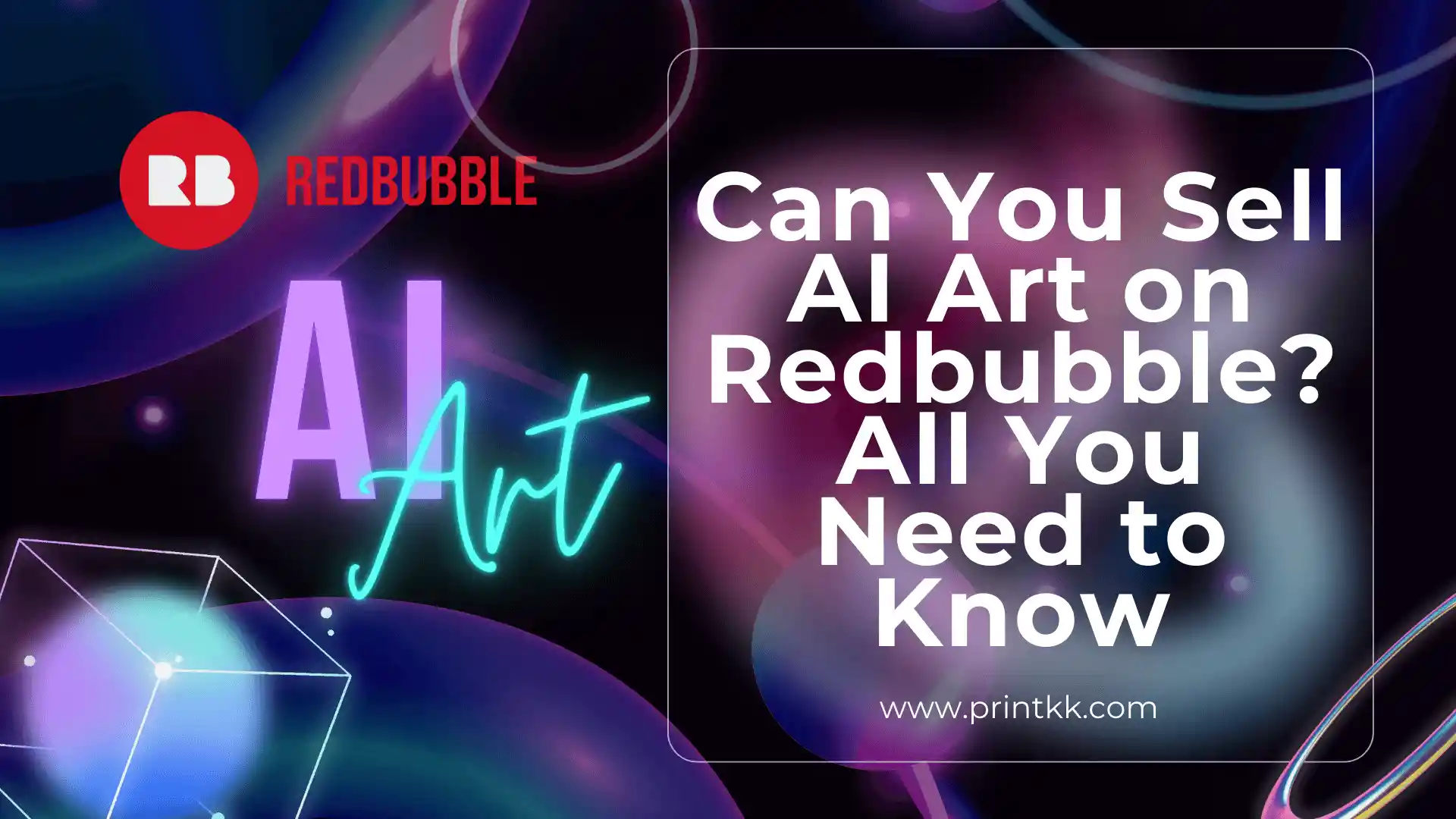
Ever wondered if you can sell AI-generated art on Redbubble? Well, you're in the right place! As the world of art and technology collides, a new wave of creativity is emerging, and it's taking the print-on-demand market by storm. Imagine blending your artistic vision with the power of artificial intelligence—it's like having a supercharged paintbrush that never runs out of ideas!
In this blog, we'll dive into everything you need to know about selling AI art on Redbubble. Whether you're an artist looking to expand your horizons or an entrepreneur eager to tap into this innovative niche, we've got you covered.
So, buckle up and get ready for an exciting journey into the future of art. With a little guidance and a lot of creativity, you'll soon discover how AI art can open up new possibilities for your Redbubble store. Let's turn those digital dreams into reality!
Learn about AI Art and Redbubble
What is AI Art?
Artificial Intelligence (AI) has been making waves in various fields, and the art world is no exception. The generative AI market is expected to grow dramatically, reaching nearly $128 billion in 2024 and surpassing $1.3 trillion by 2032.
But what exactly is AI art? Imagine teaching a computer to create art by feeding it thousands of images from different styles and eras. Over time, the machine learns patterns, techniques, and even develops its own creative touch. This results in unique pieces of artwork that blend human creativity with computational power.
AI art can range from abstract designs to realistic portraits, all generated by algorithms. It's like having a digital artist who never tires, always ready to produce something new and exciting.
For artists and designers, this opens up a whole new realm of possibilities, allowing them to experiment with styles and concepts that might be difficult to achieve manually.
What is Redbubble?
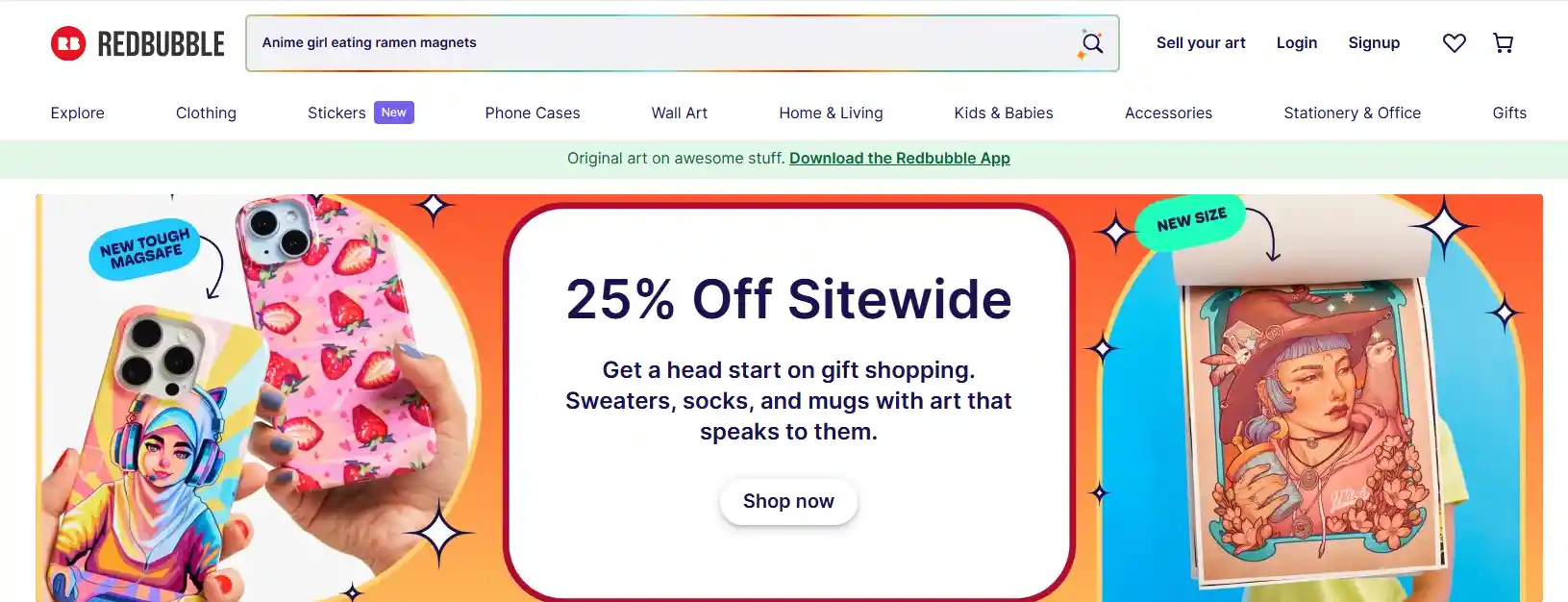
Now, let's shift gears and talk about Redbubble. If you want to sell your art, Redbubble should be the first platform you think of. In this huge online market, creativity and opportunity coexist. You can find a wide range of products such as stickers, phone cases or decorative paintings here, and then upload your artwork to these products.
Then you just need to wait for someone to place an order, and Redbubble will take care of the printing and shipping of the ordered products. The platform also offers a global audience, giving your work exposure far beyond your local community. Plus, with its easy-to-use interface, setting up your shop and managing your listings is a breeze.
Why Choose to Sell AI Art on Redbubble?
The Power of AI Art
AI art is a game-changer in the creative world. By leveraging advanced algorithms and machine learning, AI can generate unique and innovative designs that might be challenging to create manually.
This technology allows artists to explore new styles, experiment with complex patterns, and produce artwork that stands out in a crowded market. Imagine having a tireless assistant who can continuously churn out fresh, eye-catching designs. That's the magic of AI art.
The Simplicity of AI Art
The most attractive thing about AI art is that it is very easy to get started. Even if you are not a professional designer, you can create beautiful illustrations. Creating art with AI tools can be as simple as inputting a few parameters or feeding the algorithm some sample images.
This simplicity not only allows you to create high quality designs, but also to quickly produce multiple designs to increase your creative efficiency.
Whether you're a design beginner looking to learn design or an experienced artist looking to expand your design thinking, artificial intelligence can meet many of your needs and make the creative process easier.
Diverse Product Range
Redbubble offers a wide array of products that can feature your AI art, from apparel like t-shirts and hoodies to home decor items such as mugs and wall art. This variety allows you to cater to different tastes and preferences, increasing the likelihood of making sales.
Imagine someone sipping their morning coffee from a mug adorned with your unique design—it's a fantastic way to make your art a part of everyday life.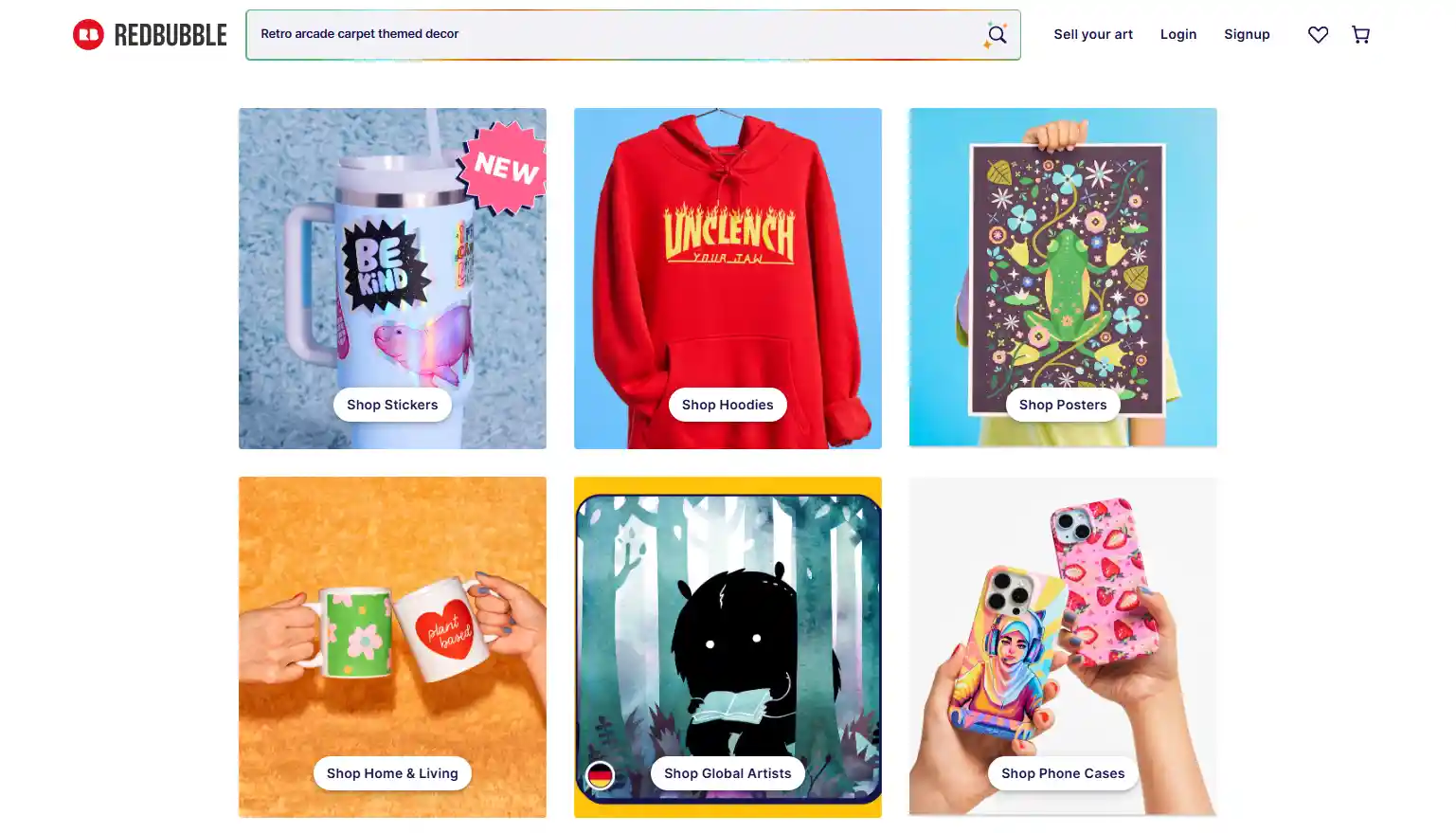
Global Reach and Exposure on Redbubble
The Redbubble AI art marketplace amplifies the potential of your creations by offering extensive global reach.
Your creations can be discovered by art enthusiasts from all corners of the world, from bustling cities like New York and Tokyo to quaint towns in Europe.
Whether it's a designer or an entrepreneur, this huge exposure can bring more attention and sales to your designs and products.
Hassle-Free Selling Process
Selling on Redbubble is incredibly straightforward. Once you upload your AI design, you can wait for the first customer to place an order. When a customer orders a product, Redbubble takes care of printing the product and shipping it to your customer.
It's like having an entire team dedicated to handling the business side of things while you concentrate on your passion.
Can You Sell AI Art on Redbubble?
Absolutely, you can sell AI art on Redbubble! However, there are a few things you need to keep in mind to ensure you're playing by the rules. Think of it like setting up a lemonade stand—yes, you can sell your refreshing drink, but you need to make sure you're using fresh lemons and not infringing on someone else's recipe.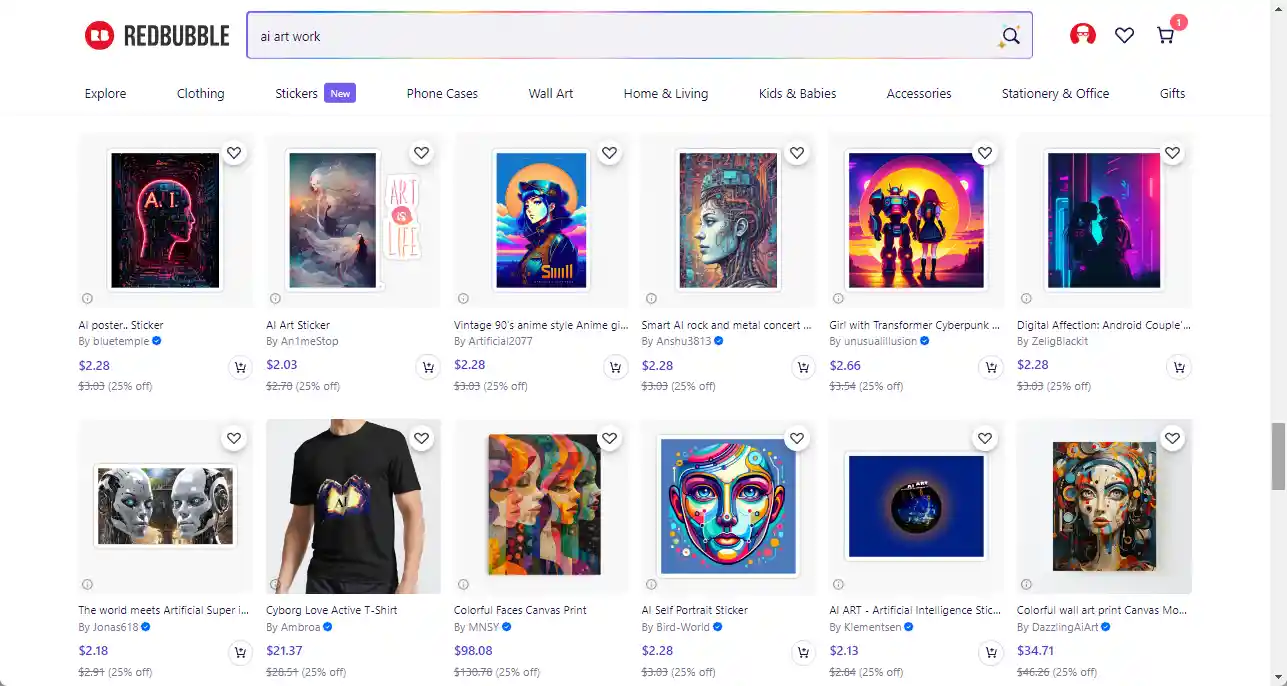
Redbubble allows artists to upload and sell AI-generated art as long as it adheres to their content guidelines. In fact, understanding the Redbubble AI policy is crucial to ensure your designs are compliant and won’t be taken down.
This means your artwork should be original and not violate any copyright laws. Just like with traditional art, if your AI art is based on or heavily influenced by existing works, you could run into legal issues. So, make sure your creations are unique and not derivative of protected content.
Consider the marketability of your AI art. While the technology behind AI-generated art is fascinating, it's the emotional connection and aesthetic appeal that will attract buyers. Experiment with different styles and themes to see what resonates most with your audience. Just as you'd tweak your lemonade recipe to suit your customers' tastes, refine your AI art offerings based on feedback and trends.
Read More:
- Comprehensive Guide: Can I Use AI Images for Print on Demand?
- Using AI Art for Print on Demand: Maximize Your Creativity
How to Sell AI Art on Redbubble?
Selling AI art on Redbubble can be a fantastic way to showcase your creativity and reach a broad audience. Let's break down the process into manageable steps so you can get started with confidence.
1. Create Unique AI Art
To get started with ai art Redbubble, you first need to create your AI-generated artwork. Think of this as your digital canvas where the possibilities are endless.
Use AI art generators like DALL-E, MidJourney, or other tools to produce unique pieces. Remember, originality is key here—your art should be distinct and not directly copied from existing works. It's like cooking up a new recipe; you want it to be fresh and exciting for your audience.
2. Prepare Your Artwork for Upload
Once you've got your masterpiece, it's time to prepare it for upload. This involves ensuring that your images are high-resolution and meet Redbubble's file requirements. Think of this step as packaging your product beautifully—presentation matters!
3. Upload Your Art
Now comes the fun part—uploading your AI art! Navigate to the "Add New Work" section on Redbubble, and follow the instructions to upload your image files. During this process, you'll be able to choose which products (like t-shirts, mugs, posters) you'd like your art to appear on. It's like deciding which items in your store will feature your latest design.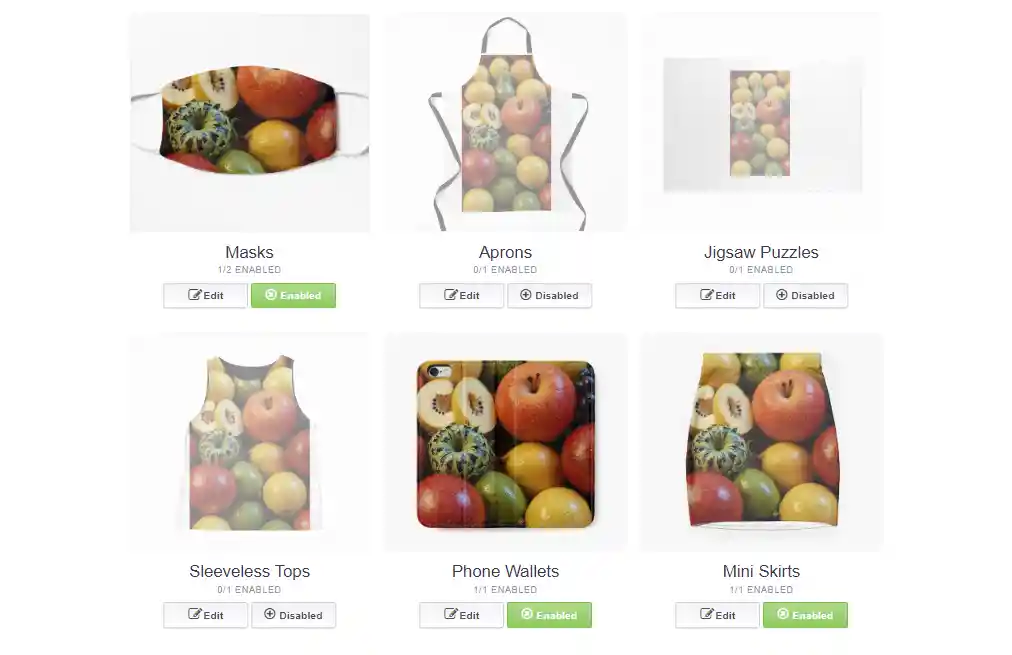
4. Optimize Your Listings
To attract potential buyers, make sure to optimize your listings with relevant keywords and tags. Write compelling titles and descriptions that highlight what makes your art special. Think about what words people might use when searching for art like yours—this is where a bit of SEO magic comes into play. It's similar to putting up eye-catching signs that draw customers into your store.
5. Promote Your Art
Don't just rely on Redbubble's traffic—promote your work through social media, email newsletters, and other marketing channels. You can share interesting stories behind the creation of your designs or the inspiration behind them. These little things will interest the audience and make them interested in the product.
Pros and Cons of Selling AI Art on Redbubble
We fully understand that selling AI art on Redbubble is a tricky business. Don't worry, we've created two simple tables to help you understand the pros and cons of selling AI art on this platform.
Pros of Selling AI Art on Redbubble
| Pros | Description |
| Cost Efficiency | Creating art with AI can be more cost-effective than traditional methods since you don't need expensive materials or studio space. Think of it as having a digital art studio at your fingertips without the overhead costs. |
| Scalability | You can easily use AI to expand your art production to meet needs without the constraints of the manual creative process. This means you can cater to a larger audience and potentially significantly increase your sales. |
| Wide Reach | Redbubble has a global audience, giving your art exposure to potential buyers from all over the world—like setting up shop in a bustling international market. |
| Creative Freedom | AI tools allow you to experiment with endless creative possibilities, enabling you to produce unique and innovative designs quickly. |
| No Inventory Hassles | Redbubble handles all the production, shipping, and customer service, freeing you from the logistical headaches of traditional retail. |
Cons of Selling AI Art on Redbubble
| Cons | Description |
| Competition | The platform is saturated with artists, making it challenging to stand out among thousands of other designs. |
| Quality Control | Since you're not handling the production, there might be occasional issues with print quality or product durability that are out of your control. |
| Royalties | The profit margins can be lower compared to selling directly due to Redbubble's cut of each sale. It's akin to sharing your lemonade stand earnings with the person who provided the lemons and the stand. |
| Copyright Concerns | Navigating copyright laws can be tricky, especially if your AI art closely resembles existing works or uses copyrighted material as input. |
| Dependence on Platform Policies | Your ability to sell is subject to Redbubble's policies and guidelines, which can change at any time—similar to renting a booth at a market where rules might shift unexpectedly. |
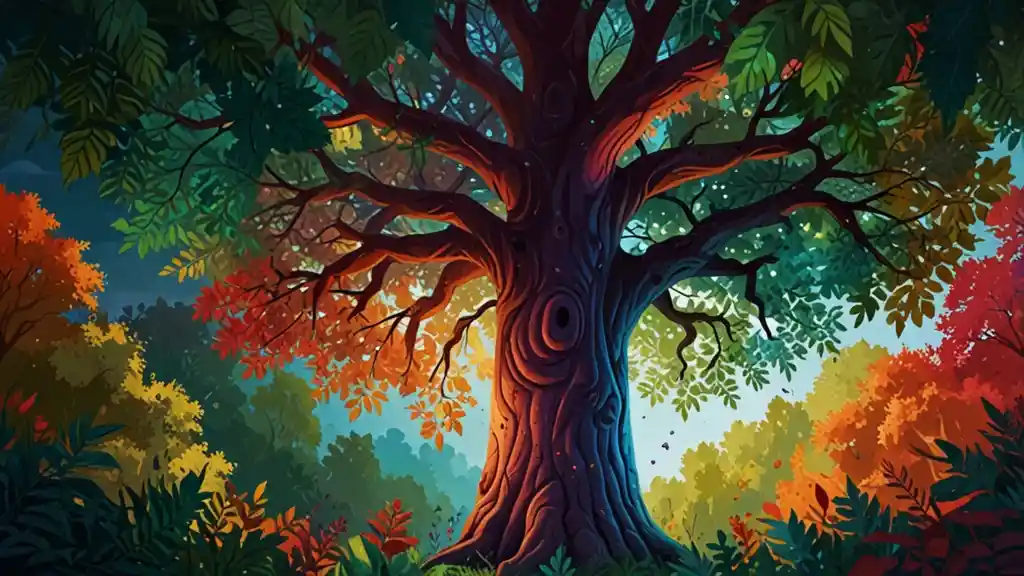
Things to Note When Selling Ai Art on Redbubble
Understand Redbubble's Content Guidelines
Before you start uploading your AI-generated masterpieces, it's crucial to familiarize yourself with Redbubble's content guidelines, especially the Redbubble AI art policy.
Redbubble has specific rules about what kind of content is allowed, and understanding these will help you avoid any potential pitfalls. Make sure your AI art doesn't infringe on copyrights or violate community standards.
Quality Over Quantity
While AI can generate a large volume of art quickly, it's important to focus on quality rather than quantity. Imagine you're at a farmer's market; customers are more likely to buy beautifully crafted goods rather than mass-produced items. Take the time to curate and refine your AI-generated pieces to ensure they stand out and appeal to potential buyers.
Transparency About AI Creation
Being transparent about the use of AI in creating your artwork can build trust with your audience. It's like sharing the secret ingredient in a beloved family recipe; people appreciate honesty and originality. Clearly mention in your product descriptions that the art was created using AI technology. This not only sets proper expectations but also showcases your innovative approach.
Stay Updated with Technology and Trends
The field of AI art is rapidly evolving, much like fashion trends that change with the seasons. Staying updated with the latest advancements in AI technology and current trends in digital art can give you a competitive edge. Regularly experiment with new tools and techniques to keep your portfolio fresh and engaging.
Real Comments on Reddit and Quora About Selling AI Art
Navigating the world of selling AI art can be both exciting and daunting. To shed light on this evolving landscape, we've gathered real comments from Reddit and Quora users who have shared their experiences and insights. Their advice offers valuable perspectives on the challenges and opportunities of selling AI-generated art on platforms like Redbubble.
Insights from Reddit
Jerr-artist shared some crucial insights about the complexities of selling AI art. They emphasized the importance of understanding your AI art provider's rules. For instance, platforms like Midjourney retain rights to the generated art, meaning users might be inadvertently working for the company for free or even paying them through subscriptions.
Jerr-artist also pointed out that copyright laws surrounding AI art are currently under heavy scrutiny. The legal landscape is evolving, and there's a potential risk of financial liability if you profit from AI-generated art without clear rights.
To mitigate this risk, they suggest finding an AI generator that allows you to retain rights and encourages extensive customization through original images, text inputs, and color choices. Additionally, using tools like Photoshop to further modify AI-generated images can help create something unique and protect your interests.
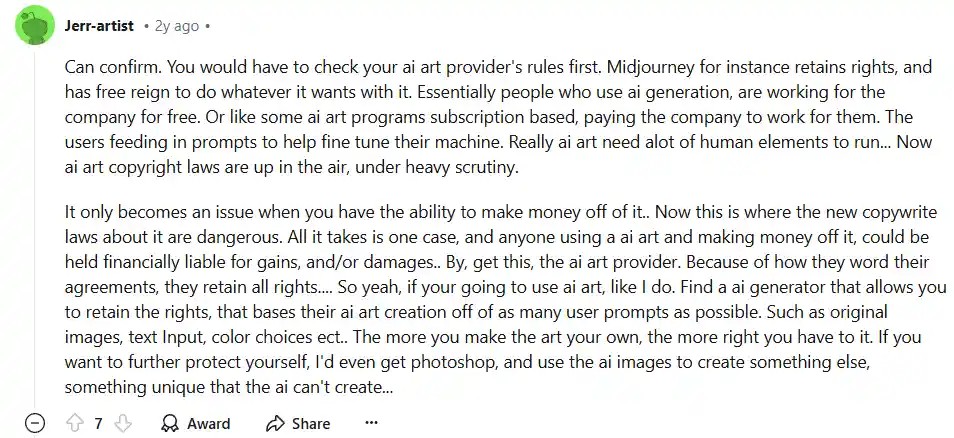
Insights from Quora
On Quora, Jendor Man provided practical advice for successfully selling AI art on platforms like Etsy and Redbubble. They recommended finding a niche that helps you stand out and using targeted keywords to attract your ideal customers. This is akin to setting up a shop in a busy marketplace; you need to make sure people can find you easily.
Jendor Man also suggested showcasing your art with mockups to help potential buyers visualize owning it. Offering a variety of products at different price points can cater to a broader audience. They advised playing to the strengths of each platform—leveraging Etsy's focus on handmade items and Redbubble's appeal to fandoms.
Transparency about using AI in your creative process is another key point. Staying updated on evolving laws related to AI art is crucial to ensure compliance and avoid potential legal issues.
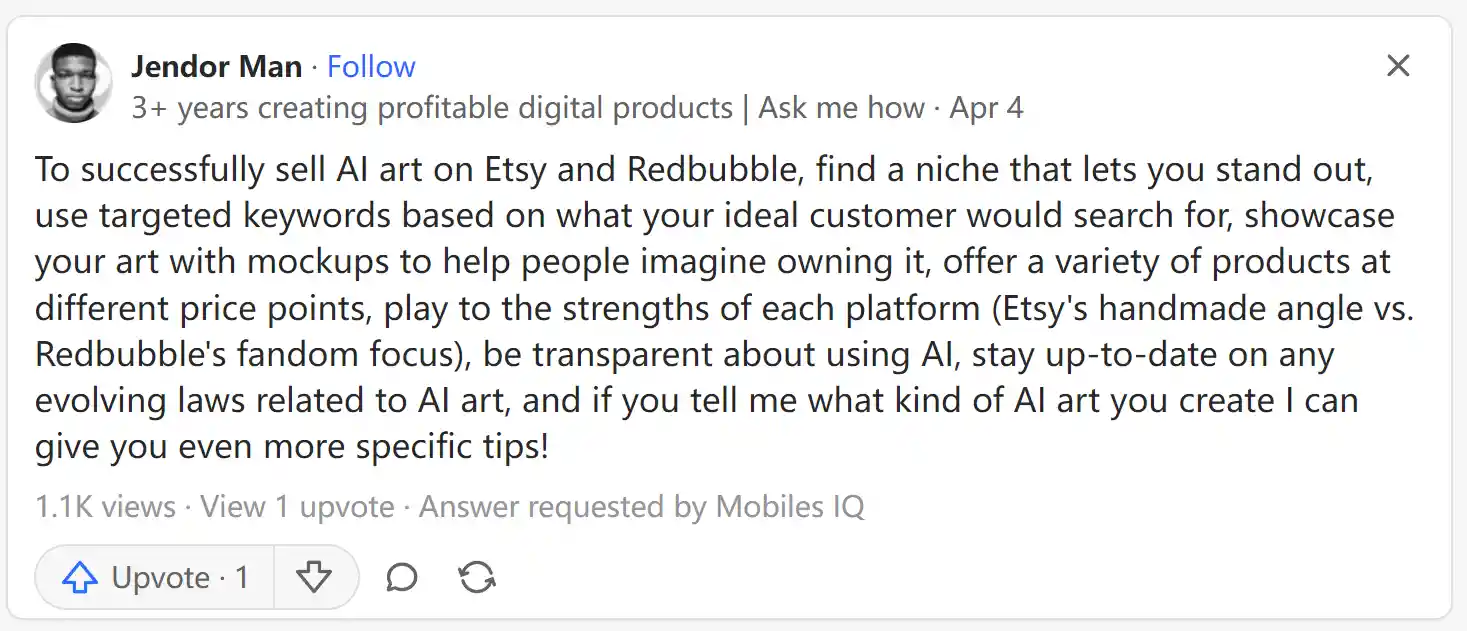
By integrating these real-world insights, you can navigate the intricacies of selling AI art on Redbubble more effectively. Embrace the opportunities while being mindful of the challenges, and let your creativity flourish!
Expert Tips
Selling AI art on Redbubble is not just possible—it's an exciting frontier for creative entrepreneurs and artists alike. By understanding the platform's guidelines, focusing on quality, being transparent about your use of AI, and staying updated with technological trends, you can carve out a unique space in the market. Think of it as planting a garden; with careful tending and attention, your AI art can flourish and attract a diverse audience.
Remember, the world of AI art is evolving rapidly, much like a thrilling roller coaster ride. Embrace the innovation, stay informed about legal considerations, and continuously refine your craft. This journey offers immense potential for those willing to explore and experiment.
So, gear up and dive into this vibrant landscape with confidence. Your creativity combined with cutting-edge technology can lead to remarkable success on Redbubble. The future of art is here—make it yours!
FAQs
What other platforms can I sell AI art on?
Besides Redbubble, you can sell AI art on platforms like Etsy, Society6, Zazzle, and DeviantArt. These sites offer great exposure and a variety of product options for your AI-generated artwork.
What are some good AI art generators?
Popular AI art generators include DALL-E by OpenAI, DeepArt, and Artbreeder. These tools use advanced algorithms to create unique artworks based on your inputs.
Is the image generated by AI good enough to print?
Yes, many AI art generators produce high-resolution images suitable for printing. Ensure you check the quality and resolution before printing to achieve the best results.










 Global Shipping
Global Shipping




 Made in USA
Made in USA

























